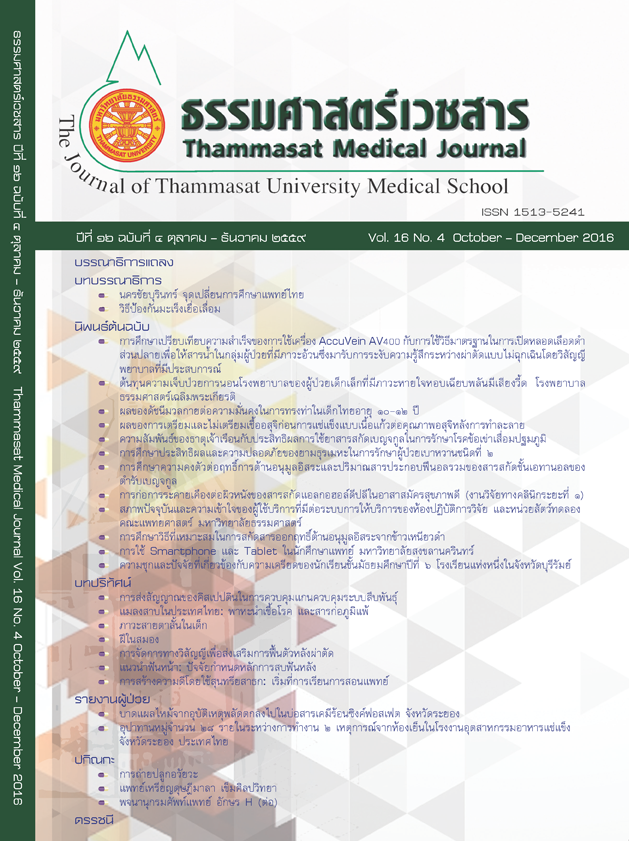A randomized controlled trial comparing the AccuVein AV400 device to standard insertion technique for peripheral intravenous cannulation by experienced nurse anesthetists in obese patients undergoing elective surgery
Keywords:
Obesity, Peripheral venous access, Intravenous cannulation, Near-infrared light, AccuVein AV400, ภาวะอ้วน, การเปิดหลอดเลือดดำ, อุปกรณ์, อินฟราเรด, เครื่องมือ AccuVein AV400Abstract
Introduction: Obesity is a predictive factor for difficulty in peripheral intravenous insertion. The AccuVein AV400 device was developed to assist in peripheral vein identification and venipuncture. It can identify peripheral veins lying 10 mm subcutaneously using near infrared laser light. Objective was to evaluate the efficacy of the AccuVein AV400 device in improving the first-time success rate of peripheral intravenous cannulation in obese patients.
Method: Seventy-two patients with a body mass index (BMI) of 30 kg/m2 or more were randomized into two groups; the AV400 group (using the AccuVein AV400 device for peripheral venous insertion) and a standard group (using the naked eye and/or palpation for peripheral venous insertion). The providers were three experienced nurse anesthetists. An observer recorded the number of attempts to successful cannulation and the time between tourniquet application and successful cannulation. Failure was defined as when more than four cannulation attempts were done in either technique.
Result: The BMIs of the two groups were comparable [33.7 ± 4.6 kg/m2 in the AV400 group and 34.0 ± 4.6 kg/m2 in the standard group; (p = 0.77)]. There was no significant difference in the first-attempt success rate between the AV400 group (52.8%) and the standard group (58.3%) (p = 0.81). The time to success was 41.5 (17.5 - 62.5) seconds (95% CI, 36.1 - 115.8) using the AV400 device and 77 (27 - 120) seconds (95% CI, 57.3 - 214.3) with the standard technique (p = 0.12).
Discussion and Conclusion: Although the AccuVein AV400 improved visualization of the peripheral veins, we found no statistically significant difference in first-attempt success rates between standard cannulation and the use of the AccuVein AV400 device in unselected obese patients.
Key words: Obesity, Peripheral venous access, Intravenous cannulation, Near-infrared light, AccuVein AV400
การศึกษาเปรียบเทียบความสำเร็จของการใช้เครื่อง AccuVein AV400 กับการใช้วิธีมาตรฐานในการเปิดหลอดเลือดดำส่วนปลายเพื่อให้สารน้ำในกลุ่มผู้ป่วยที่มีภาวะอ้วนซึ่งมารับการระงับความรู้สึกระหว่างผ่าตัดแบบไม่ฉุกเฉินโดยวิสัญญีพยาบาลที่มีประสบการณ์
ชลทิชา ศรีภักดี, ศิรินทิพย์ สว่างวงศ์, ปริฉัตร เคอร์รี่, ศิริวัน ตติยานุพันธ์วงศ์
บทคัดย่อ
บทนำ: ภาวะอ้วนเป็นปัจจัยอย่างหนึ่งที่มีผลต่อความสำเร็จในการเปิดหลอดเลือดกำส่วนปลาย ซึ่งเครื่อง AccuVein AV400 เป็นอุปกรณ์ที่ใช้แสงอินฟราเรดในการช่วยส่องหาหลอดเลือดดำส่วนปลายได้ลึกถึง ๑๐ มิลลิเมตรจากผิวหนัง การศึกษาครั้งนี้ทมีวัตถุประะสงค์เพื่อศึกษาว่าการใช้เครื่อง AccuVein AV400 สามารถช่วยเพมิ่ ความสำเร็จในการเปิดหลอดเลือดดำส่วนปลายในครั้งแรก ซึ่งกระทำในผู้ป่วยที่มีภาวะอ้วนได้หรือไม่
วิธีการศึกษา: ได้มีการแบ่งผู้ป่วย ๗๒ คนที่มีดัชนีมวลกายอย่างน้อย ๓๐ กิโลกรัม/เมตร๒ เป็นสองกลุ่มคือ กลุ่มที่เปิดหลอดเลือดดำโดยนำอุปกรณ์ AccuVein AV400 เข้าช่วย กับกลุ่มที่ใช้วิธีมาตรฐานในการเปิดหลอดเลือดดำส่วนปลาย ซึ่งผู้ที่ทำการเปิดหลอดเลือดดำคือพยาบาลเฉพาะทางวิสัญญีที่มีประสบการณ์ในการเปิดหลอดเลือดทั้งหมด ๓ คน ผู้สังเกตการณ์จะทำหน้าที่จดบันทึกจำนวนครั้งที่แทงเข็มหรือเปลี่ยนทิศทางเข็ม และระยะเวลาตั้งแต่เริ่มรัดทูนิเกต์จนกระทั่งเปิดหลอดเลือดดำส่วนปลายสำเร็จหรือล้มเหลว โดยถือการล้มเหลวคือ การแทงเข็มหรือเปลี่ยนทิศทางของเข็มมากกว่า ๔ ครั้ง
ผลการศึกษา: ดัชนีมวลกายของผู้ป่วยทั้งสองกลุ่มไม่แตกต่างกัน [๓๓.๗ ± ๔.๖ กิโลกรัม/เมตร๒ ในกลุ่มที่ใช้เครื่อง AccuVeinAV400 และ ๓๔.๐ ± ๔.๖ กิโลกรัม/เมตร๒ ในกลุ่มที่ใช้วิธีมาตรฐาน; (p = ๐.๗๗)] และพบว่าไม่มีความแตกต่างกันอย่างมีนัยสำคัญในจำนวนครั้งแรกที่เปิดหลอดเลือดดำสำเร็จระหว่างกลุ่มที่ใช้เครื่อง AccuVein AV400 (ร้อยละ ๕๒.๘) กับกลุ่มที่ใช้วิธีมาตรฐาน (ร้อยละ ๕๘.๓) (p = ๐.๘๑) นอกจากนี้ยังพบว่ากลุ่มที่ใช้เครื่อง AccuVein AV400 ใช้ระยะเวลาตั้งแต่รัดทูนิเกต์จนเปิดหลอดเลือดดำสำเร็จ ๔๑.๕ (๑๗.๕ - ๖๒.๕) วินาที (95% CI, ๓๖.๑ - ๑๑๕.๘) ในขณะที่กลุ่มที่ใช้วิธีมาตรฐานใช้เวลา ๗๗ (๒๗ - ๑๒๐) วินาที (95% CI, ๕๗.๓ - ๒๑๔.๓) (p = ๐.๑๒)
วิจารณ์ และสรุปผลการศึกษา: ถึงแม้ว่าการใช้เครื่อง AccuVein AV400 จะช่วยทำให้เห็นหลอดเลือดดำส่วนปลายชัดเจนขึ้น แต่พบว่าความสำเร็จในการเปิดหลอดเลือดดำในแรกในผู้ป่วยที่มีภาวะอ้วนระหว่างกลุ่มที่ใช้เครื่อง AccuVein AV400 กับกลุ่มที่ใช้วิธีมาตรฐานไม่แตกต่างกันอย่างมีนัยสำคัญทางสถิติ
คำสำคัญ: ภาวะอ้วน, การเปิดหลอดเลือดดำ, อุปกรณ์, อินฟราเรด, เครื่องมือ AccuVein AV400



